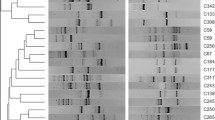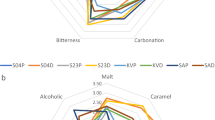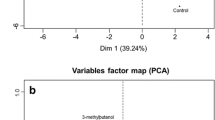Abstract
Twelve bacterial strains belonging to eight taxonomic groups: Brevibacterium linens, Microbacterium foliorum, Arthrobacter arilaitensis, Staphylococcus cohnii, Staphylococcus equorum, Brachybacterium sp., Proteus vulgaris and Psychrobacter sp., isolated from different surface-ripened French cheeses, were investigated for their abilities to generate volatile aroma compounds. Out of 104 volatile compounds, 54 volatile compounds (identified using dynamic headspace technique coupled with gas chromatography-mass spectrometry [GC-MS]) appeared to be produced by the different bacteria on a casamino acid medium. Four out of eight species used in this study: B. linens, M. foliorum, P. vulgaris and Psychrobacter sp. showed a high flavouring potential. Among these four bacterial species, P. vulgaris had the greatest capacity to produce not only the widest varieties but also the highest quantities of volatile compounds having low olfactive thresholds such as sulphur compounds. Branched aldehydes, alcohols and esters were produced in large amounts by P. vulgaris and Psychrobacter sp. showing their capacity to breakdown the branched amino acids. This investigation shows that some common but rarely mentioned bacteria present on the surface of ripened cheeses could play a major role in cheese flavour formation and could be used to produce cheese flavours.

Similar content being viewed by others
References
Ansede JH, Friedman R, Yoch DC (2001) Phylogenetic analysis of culturable dimethyl sulfide-producing bacteria from a spartina-dominated salt marsh and estuarine water. Appl Environ Microbiol 67:1210–1217
Ardo Y (2006) Flavour formation by amino acid catabolism. Biotechnol Adv 24:238–242
Arfi K, Spinnler HE, Tache R, Bonnarme P (2002) Production of volatile compounds by cheese-ripening yeasts: requirement for a methanethiol donor for S-methyl thioacetate synthesis by Kluyveromyces lactis. Appl Microbiol Biotechnol 58:503–510
Arfi K, Amarita F, Spinnler HE, Bonnarme P (2003) Catabolism of volatile sulfur compounds precursors by Brevibacterium linens and Geotrichum candidum, two microorganisms of the cheese ecosystem. J Biotechnol 105:245–253
Barbieri G, Bolzoni L, Careri M, Manglia A, Parolari G, Spagnoli S, Virgili R (1994) Study of the volatile fraction of Parmesan cheese. J Agric Food Chem 42:1170–1176
Beresford TP, Fitzsimons NA, Brennan NL, Cogan TM (2001) Recent advances in cheese microbiology. Int Dairy J 11:259–274
Bockelmann W, Willems KP, Neve H, Heller KH (2005) Cultures for the ripening of smear cheeses. Int Dairy J 15:719–732
Bonnarme P, Psoni L, Spinnler HE (2000) Diversity of l-methionine catabolism pathways in cheese-ripening bacteria. Appl Environ Microbiol 66:5514–5517
Bosset JO, Liardon R (1984) The aroma composition of Gruyère cheese. II. The neutral volatile components. Lebensm-Wiss Technol 17:359–362
Bowman JP, Cavanagh J, Austin JJ, Sanderson K (1996) Novel Psychrobacter species from Antarctic ornithogenic soil. Int J Syst Bacteriol 46:841–848
Buzzini P, Romano S, Turchetti B, Vaughan A, Pagnoni UM, Davoli P (2005) Production of volatile organic sulfur compounds (VOSCs) by basidiomycetous yeasts. FEMS Yeast Res 5:379–385
Casey J, Dobb R (1992) Microbial routes to aromatic aldehydes. Enzyme Microb Technol 14:739–747
Cuer A, Dauphin G, Kergomard A, Dumont JP, Adda J (1979) Production of S-methylthioacetate by Brevibacterium linens. Appl Environ Microbiol 38:332–334
Curioni PMG, Bosset JO (2002) Key odorants in various cheese types as determined by gas chromatography-olfactometry. Int Dairy J 12:959–984
Demarigny Y, Berger C, Desmasures N, Gueguen M, Spinnler HE (2000) Flavour sulphides are produced from methionine by two different pathways by Geotrichum candidum. J Dairy Res 67:371–380
Dumont JP, Degas C, Adda J (1976) L’arôme du Camembert: autre composé mineurs mis en évidence. Lait 535–536:243–251
Feurer C, Irlinger F, Spinnler HE, Glaser P, Vallaeys T (2004) Assessment of the rind microbial diversity in a farmhouse-produced vs a pasteurized industrially produced soft red-smear cheese using both cultivation and rDNA-based methods. J Appl Microbiol 97:546–556
Gallois A, Langlois D (1990) New results in the volatile odorous compounds of French cheese. Lait 70:89–106
Gonzàles de Llano D, Rodriguez A, Cuesta P (1996) Effect of lactic starter cultures on the organic acid composition of milk and cheese during ripening-analysis by HPLC. J Appl Bacteriol 80:570–576
Helinck S, Spinnler HE, Parayre S, Dame-Cahagne M, Bonnarme P (2000) Enzymatic versus spontaneous S-methyl thioester synthesis in Geotrichum candidum. FEMS Microbiol Lett 193:237–241
Irlinger F, Bergère J (1999) Use of conventional biochemical tests and analyses of ribotype patterns for classification of micrococci isolated from dairy products. J Dairy Res 66:91–103
Irlinger F, Morvan A, El-Solh N, Bergère J (1997) Taxonomic characterization of coagulase-negative staphylococci in ripening flora from traditional French cheeses. Syst Appl Microbiol 20:319–328
Jollivet N, Bézenger M-C, Vayssier Y, Belin J-M (1992) Production of volatile compounds in liquid cultures by six strains of coryneform bacteria. Appl Microbiol Biotechnol 36:790–794
Kagkli DM, Tache R, Cogan TM, Hill C, Casaregola S, Bonnarme P (2006) Kluyveromyces lactis and Saccharomyces cerevisiae, two potent deacidifying and volatile-sulphur-aroma-producing microorganisms of the cheese ecosystem. Appl Microbiol Biotechnol 73:434–442
Kondjoyan N, Berdagué JL (1996) A compilation of relative retention indices for the analysis of aromatic compounds. Edition du Laboratoire Flaveur. Station de recherche sur la viande, INRA de Theix, Saint Genes Champanelle, France, pp 234
Lamberet G, Auberger B, Bergère JL (1997) Aptitude of cheese bacteria for volatile S-methyl thioester synthesis I. Effect of substrates and pH on their formation by Brevibacterium linens GC171. Appl Microbiol Biotechnol 47:279–283
Moio L, Dekimpe J, Etievant PX, Addeo F (1993) Volatile flavour compounds of water buffalo mozzarella cheese. Ital J Food Sci 5:57–68
Molimard P, Spinnler HE (1996) Review: compounds involved in the flavor of surface mold-ripened cheeses: origins and properties. J Dairy Sci 79:169–184
Moller JK, Hinrichsen LL, Andersen HJ (1998) Formation of amino acid (l-leucine, l-phenylalanine) derived volatile flavour compounds by Moraxella phenylpyruvica and Staphylococcus xylosus in cured meat model systems. Int J Food Microbiol 42:101–117
Monnet C, Correia K, Sarthou AS, Irlinger F (2006) Quantitative detection of Corynebacterium casei in cheese by real-time PCR. Appl Environ Microbiol 72:6972–6979
Morales P, Fernandez-Garcia E, Nunez M (2005) Production of volatile compounds in cheese by Pseudomonas fragi strains of dairy origin. J Food Prot 68:1399–1407
Prado B, Jara A, Moral AD, Sanchez E (2001) Numerical taxonomy of microorganisms isolated from goat cheese made in Chile. Curr Microbiol 43:396–399
Reps A (1993) Bacteria surface-ripened cheeses. In: Fox PF (ed) Cheese: chemistry, physics and microbiology, 2nd edn. Chapman & Hall, London, pp 137–172
Roje S (2006) S-Adenosyl-l-methionine: beyond the universal methyl group donor. Phytochemistry 67:1686–1698
Rychlik M, Bosset JO (2001) Flavour and off-flavour compounds of Swiss Gruyère cheese. Identification of key odorants by quantitative instrumental and sensory studies. Int Dairy J 11:903–910
Thierry A, Maillard MB, Yvon M (2002) Conversion of l-leucine to isovaleric acid by Propionibacterium freudenreichii TL 34 and ITGP23. Appl Environ Microbiol 68:608–615
Urbach G (1993) Relation between cheese flavour and chemical composition. Int Dairy J 3:389–422
Valdes-Stauber N, Scherer S, Seiler H (1997) Identification of yeasts and coryneform bacteria from the surface microflora of brick cheeses. Int J Food Microbiol 34:115–129
Welsh FW, Murray WD, Williams RE (1989) Microbiological and enzymatic production of flavor and fragrance chemicals. Crit Rev Biotechnol 9:105–169
Acknowledgements
P. Deetae is grateful to the Royal Thai government for a Ph.D. scholarship. A. Helias is gratefully acknowledged for the statistical analysis technique and Chandanie Hunter for reviewing the English language.
Author information
Authors and Affiliations
Corresponding author
Rights and permissions
About this article
Cite this article
Deetae, P., Bonnarme, P., Spinnler, H.E. et al. Production of volatile aroma compounds by bacterial strains isolated from different surface-ripened French cheeses. Appl Microbiol Biotechnol 76, 1161–1171 (2007). https://doi.org/10.1007/s00253-007-1095-5
Received:
Revised:
Accepted:
Published:
Issue Date:
DOI: https://doi.org/10.1007/s00253-007-1095-5




